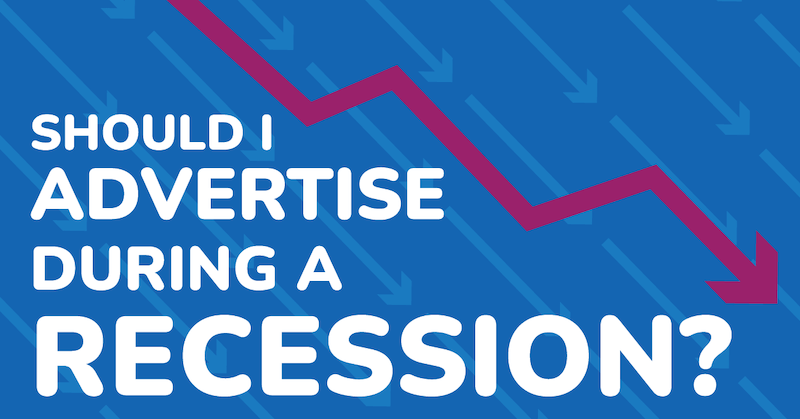Should I advertise during a recession?

Few words are scarier than the one floating around at the moment: recession. Just reading or hearing it out loud is enough to bring worries to anyone’s mind – especially if you’re a business owner. What will the future hold? Will my business be safe? Should I advertise during a recession? When it comes to your business, conventional wisdom will tell you to cut back on any and all spending in hard times, especially when it comes to advertising. After all, it will save you money in the short term, and you can make up the difference when the economy picks back up.
But what if the conventional wisdom isn’t so wise? As it turns out, research actually shows that advertising during a recession can cost you less and gain you more. Of course, every situation and every business is different, and we wouldn’t dream of offering a one-size-fits-all solution to your recession woes. But we’re hoping that we can convince you to look at marketing spending in a recession a little differently. Here’s why this topic deserves a closer look.
What we can learn from past recessions
When the economy takes a downturn, it’s completely understandable to react by cutting costs. You have to keep the lights on somehow, right? While every recession is unique, with its own causes and remedies, there have been enough recessions in US history that we can draw some conclusions.Your content goes here. Edit or remove this text inline or in the module Content settings. You can also style every aspect of this content in the module Design settings and even apply custom CSS to this text in the module Advanced settings.
Recession advertising by the numbers
McGraw-Hill Research ran a study looking at advertising spending during the 1981-1982 recession. They studied 600 companies in 16 different industries, spanning the years of 1980-1985. Here’s what they found:
%
Increase in sales post-recession for companies that maintained or increased advertising efforts
%
Increase in sales post-recession for companies that cut budgets or stopped advertising
While the exact figures fluctuate throughout history, the pattern is clear: advertising during a recession can pay off in a big way. This has been shown to be true since the 1920’s – when companies who advertised during the Great Depression saw a rise of 20% compared to the 7% loss of companies who didn’t advertise – all the way through until today.
Choosing to cut back or eliminate advertising when the economy falters is understandable. But the numbers show that it could be a huge missed opportunity for your business. When other companies stop advertising, you get a great opportunity to gain share of voice in the market. With fewer companies advertising, inventory will be cheaper, and you’ll have less competition for attention. Your dollars can actually go further, if you spend them right and back them up with the right messaging.
To crystallize this point even further, here’s a brief but famous case study:

Post vs. Kellogg’s
There’s no recession more famous than the Great Depression. When the economy plummeted in the late 1920s, two breakfast cereal brands reacted very differently. Post quickly decided that the best thing to do was cut costs. They slashed their budgets and greatly diminished their advertising efforts. After all, they needed to save money, and that money needed to come from somewhere.
Kellogg’s decided to take a different tack. Instead of cutting costs, they doubled their advertising budget. They decided to move into new forms of media and pushed their new products relentlessly. Which of these two companies do you think did better?
Given the premise of this article, the answer is probably not surprising: Kellogg’s bold move paid off in the form of a nearly 30% rise in profits. And it seems that this move may have ripple effects to this day. We’re willing to bet that if you asked anyone to name a cereal brand, 9/10 people would name Kellogg’s before they even thought of Post.
Of course, your brand (probably) isn’t Kellogg’s, and everyone’s situation is different. But it’s a helpful illustration of how you can weather a recession and turn it into an advantage.
What we can’t learn from past recessions
Clearly, there’s plenty to be learned from past recessions. But equally as important is what we can’t learn – meaning, the things that have changed since then. The biggest recession fresh in everyone’s mind is likely the recession of 2008. Although it doesn’t seem that long ago in the grand scheme of things, in many ways, it was a different world. Consider that in 2008:

Almost all advertising was linear, meaning that one message went out to every viewer/listener.

The iPhone was one year old.
Digital advertising had only existed for around a decade.
Social media as we now know it – ever-present, and a necessity for every business – didn’t exist.

Streaming audio was only a few years old, and podcasts were nearly unheard of.
If you wanted to get your message out, you had options – but nowhere near the number of options you have today. Today, there are new forms of advertising that didn’t even exist back then. And perhaps even more importantly, an advertiser’s ability to target with precision has skyrocketed. That means that now more than ever, you can find your audience and target them with a message made for them and their specific interests. No longer is it your only option to spread a broad message to a massive group of people. Now, you can target a specific audience that you know is more likely to convert – which could mean potential cost savings.
Any business decisions during economic hardship should be taken seriously, and with the advice of trusted experts. The fact is that the advertising landscape looks completely different to how it used to in previous recessions, and past recessions show that keeping up your advertising when times are tough could pay off in spades. The question may end up not being “can I afford to advertise during a recession?” but rather, “can I afford not to advertise during a recession?”


